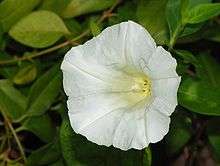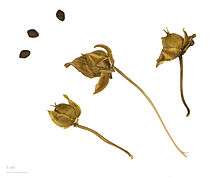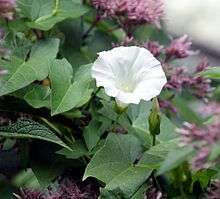Calystegia sepium
Calystegia sepium (hedge bindweed,[1] Rutland beauty, bugle vine, heavenly trumpets, bellbind, granny-pop-out-of-bed[2]) (formerly Convolvulus sepium) is a species of bindweed, with a subcosmopolitan distribution throughout the temperate Northern and Southern hemispheres.
| Calystegia sepium | |
|---|---|
 | |
| Calystegia sepium | |
| Scientific classification | |
| Kingdom: | Plantae |
| Clade: | Tracheophytes |
| Clade: | Angiosperms |
| Clade: | Eudicots |
| Clade: | Asterids |
| Order: | Solanales |
| Family: | Convolvulaceae |
| Genus: | Calystegia |
| Species: | C. sepium |
| Binomial name | |
| Calystegia sepium | |

It is an herbaceous perennial that twines around other plants, in a counter-clockwise direction, to a height of up to 2–4 m, rarely 5 m. The pale matte green leaves are arranged spirally, simple, pointed at the tip and arrowhead shaped, 5–10 cm long and 3–7 cm broad.
The flowers are white, or pale pink with five darker stripes, produced from late spring to the end of summer. In the bud, they are covered by large bracts which remain but scarcely overlap and do not cover the sepals of the open flower.[3]:567 The open flowers are trumpet-shaped, 3–7 cm diameter, white, or pale pink with white stripes. After flowering the fruit develops as an almost spherical capsule 1 cm diameter containing two to four large, black seeds that are shaped like quartered oranges. The seeds disperse and thrive in fields, borders, roadsides and open woods.
Several regional subspecies have been described, but they are not considered distinct by all authorities:
- Calystegia sepium subsp. americana. North America.
- Calystegia sepium subsp. angulata. North America.
- Calystegia sepium subsp. appalachiana. Eastern North America.
- Calystegia sepium subsp. binghamiae. Western North America (California).
- Calystegia sepium subsp. erratica. North America.
- Calystegia sepium subsp. limnophila. Southern North America.
- Calystegia sepium subsp. roseata. Western Europe, coasts. Flowers pink.
- Calystegia sepium subsp. sepium. Europe, Asia.
- Calystegia sepium subsp. spectabilis. Siberia. Flowers often pinkish.
Other vernacular names include greater bindweed, bearbind, hedge convolvulus, hooded bindweed, old man's nightcap, wild morning glory, bride's gown, wedlock (referring to the white gown-like flowers and the binding nature of the vine), white witches hat, belle of the ball. A common childhood pastime in the UK is to 'pop' the flowers from the sepals while chanting "Granny, granny — pop out of bed".
Eradication

Calystegia sepium is a plant with showy white flowers. However, because of its quick growth, clinging vines and broad leaves, it can overwhelm and pull down cultivated plants including shrubs and small trees. It's aggressively self-seeding (seeds can remain viable as long as 30 years) and the success of its creeping rhizomes (they can be as long as 3–4 m) cause it to be a persistent weed and have led to its classification as a noxious weed.
Similar species
- Calystegia silvatica, giant bindweed, is sometimes treated as a subspecies of C. sepium
- Convolvulus arvensis, Field Bindweed, is a similar vine with much smaller features. The rear margin leaf projections are sharp.
- The leaves of Ipomoea pandurata, Wild Potato Vine, are shaped like a heart, not like an arrowhead.
Gallery
 Calystegia sepium
Calystegia sepium Calystegia sepium
Calystegia sepium
References
- "BSBI List 2007". Botanical Society of Britain and Ireland. Archived from the original (xls) on 2015-01-25. Retrieved 2014-10-17.
- World Economic Plants: A Standard Reference, Second Edition. 2013. p. 921.
- Stace, C. A. (2010). New Flora of the British Isles (Third ed.). Cambridge, U.K.: Cambridge University Press. ISBN 9780521707725.
External links
| Wikimedia Commons has media related to Calystegia sepium. |